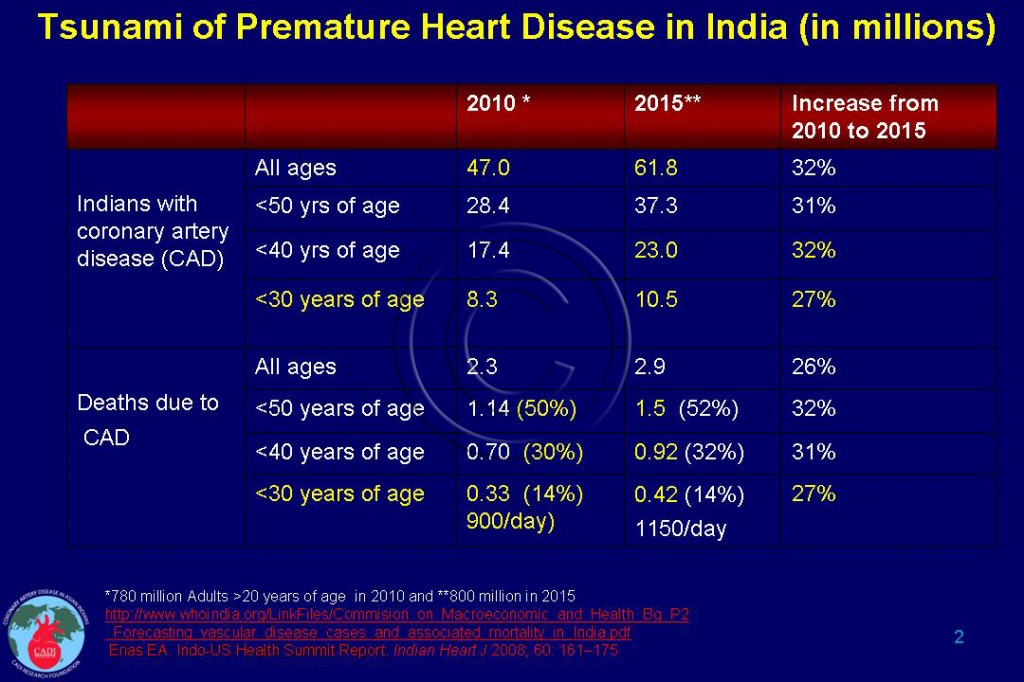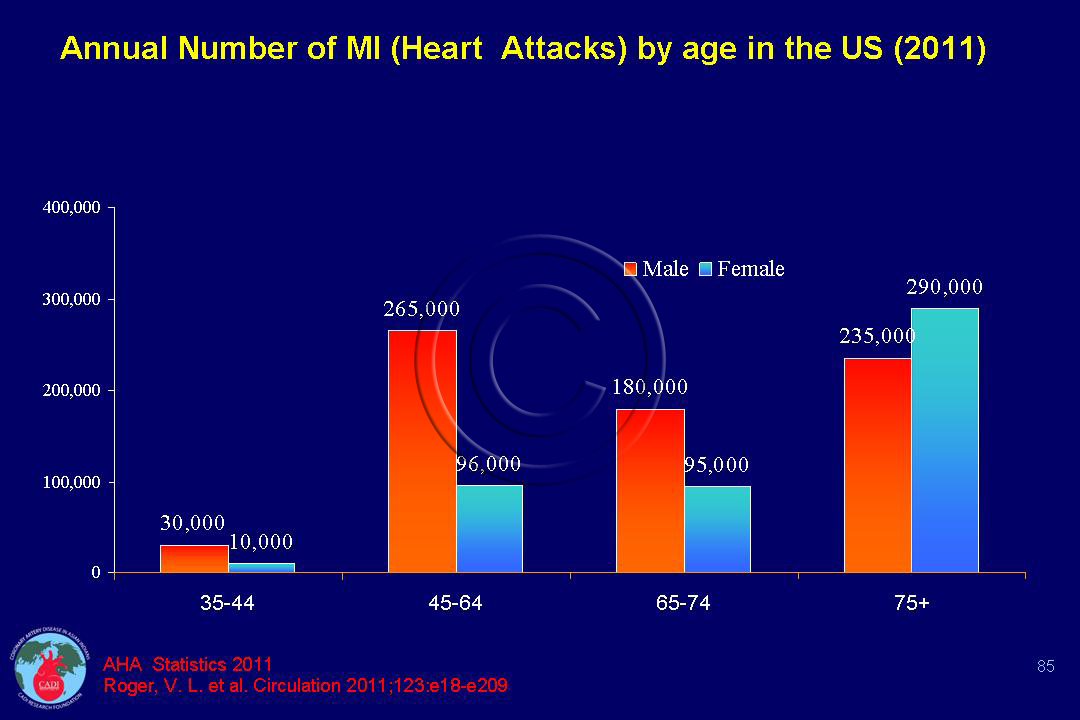- Currently, heart attack and strokes account for approximately 12 million deaths worldwide each year with a disproportionately greater burden in India. The 1.21 billion people (17% of the world’s population) of this low-income country are experiencing cardiovascular disease (CVD) morbidity and mortality at an accelerated rate.1 The population is also growing at a rate of 1.4% annually.
- More than three millions Indians die from CVD every year and are expected to surpass four million by 2020.2, 3 Estimates from the World Health Organization (WHO) show that by 2030, CVD will be the main cause of death throughout India, accounting for more than 35% of all deaths.3
- It is a sad paradox that more than 50 years of progress in the fight against CVD in most of the western world is being superseded by the rapidly rising death toll from premature coronary artery disease (CAD) in India.4, 5 Compared to western populations, CVD occurs at least 6-10 years earlier in Indians with higher rates of mortality.3, 6
- Rapid development and the resulting changes in the social fabric and physical environment are driving the CVD and other chronic diseases epidemic in India and other low and middle income countries (LMIC).
- By 2015, India is estimated to have 62 million patients with CAD. Of these, 23 million will be younger than 40 years of age and only 11 million above 60 years of age (Table 002).7
- Of the 2.9 million projected CAD deaths in 2015, an alarming 1.14 million will be younger than 50 years of age, 700,000 will be younger than 40 years of age( about 4 Boeing 777 aircraft crashing each day), and 330,000 will be younger than 30 years of age.7
- For comparison, CAD killed only 404,000 Americans in 2007 (heart attacks killed only 141,462 Americans) out of a population of more than 300 million.8
- In the US and many western counties heart disease and most of the heart attacks occur in the elderly. For instance only 30,000 men and 10% women with a heart attack are younger than 45 years in the US Figure 085.8 In sharp contrast, 17 million people are estimated to have heart disease and 700,000 people are estimated to die from CAD in India before age 40 in India and this data underscore the enormous burden of unnecessary premature deaths from malignant heart disease.
- The prevalence rates of CAD in India have increased from 1.6% to 7.4% in rural populations and from 1% to 13.2% in urban populations.9
- Stroke prevalence is less than 1% in both rural and urban areas indicating CAD is by far the dominant form of CVD.9 However, recent data indicate that the mortality from stroke has increased to nearly 50% to that of CAD.10
- India is pursuing steep global domestic product growth as a means to lift tens of millions of citizens out of poverty, promote local development, and improve quality of life. The country’s economic growth, one of the highest in the world, is raising the standard of living of millions of citizens who are joining the expanding ranks of a new middle class.5
- The rapid economic growth being experienced, leads to social and economic strains, including increases in income disparities, migration from rural to urban centers, insufficient infrastructures (e.g., transport, housing, sanitation), and social and familial disruptions. The rapid pace of urbanization results in major changes in lifestyles, including a reduction in physical activity and energy expenditure, an increase in the consumption of a pro-atherogenic diet, and increased tobacco use.5
- The capacity of India to respond adequately to the tsunami of heart disease and diabetes is affected by limited financial, human, and infrastructure resources as well as the will of the medical community and the government at large.
Sources
1. Yusuf S, Reddy S, Ounpuu S, Anand S. Global burden of cardiovascular diseases: Part II: variations in cardiovascular disease by specific ethnic groups and geographic regions and prevention strategies. Circulation. 2001;104(23):2855-2864.
2. Murray CJ, Lopez AD. Alternative projections of mortality and disability by cause 1990-2020: Global Burden of Disease Study. Lancet. May 24 1997;349(9064):1498-1504.
3. Vamadevan AS, Shah BR, Califf RM, Prabhakaran D. Cardiovascular research in India: a perspective. Am Heart J. Mar 2011;161(3):431-438.
4. Gaziano TA, Bitton A, Anand S, Abrahams-Gessel S, Murphy A. Growing epidemic of coronary heart disease in low- and middle-income countries. Curr Probl Cardiol. Feb 2010;35(2):72-115.
5. Paradis G, Chiolero A. The cardiovascular and chronic diseases epidemic in low- and middle-income countries a global health challenge. J Am Coll Cardiol. Apr 26 2011;57(17):1775-1777.
6. Enas EA, Mehta J. Malignant coronary artery disease in young Asian Indians: thoughts on pathogenesis, prevention, and therapy. Coronary Artery Disease in Asian Indians (CADI) Study. Clin Cardiol. Mar 1995;18(3):131-135.
7. Indrayan A. Forecasting vascular disease cases and associated mortality in India. 2010;http://www.whoindia.org/LinkFilesSept 25, 2010.
8. American Heart Association. Heart and Stroke Statistical Update2011.
9. Gupta R, Joshi P, Mohan V, Reddy KS, Yusuf S. Epidemiology and causation of coronary heart disease and stroke in India. Heart. Jan 2008;94(1):16-26.
10. Kim AS, Johnston SC. Global variation in the relative burden of stroke and ischemic heart disease. Circulation. Jul 19 2011;124(3):314-323.



